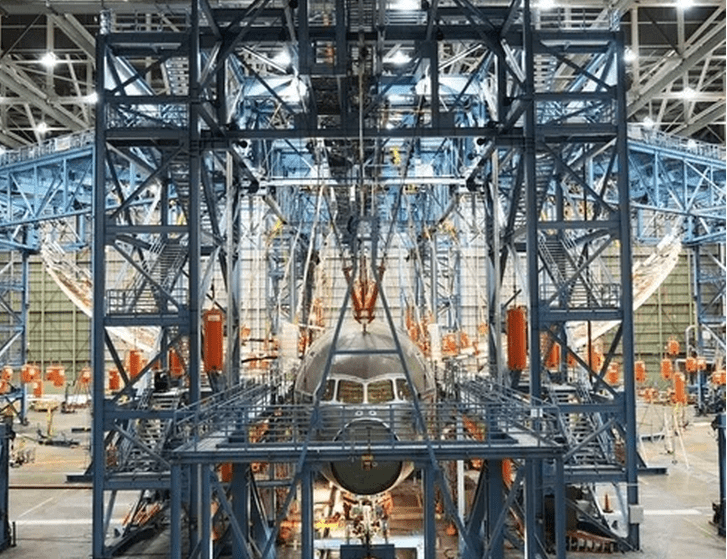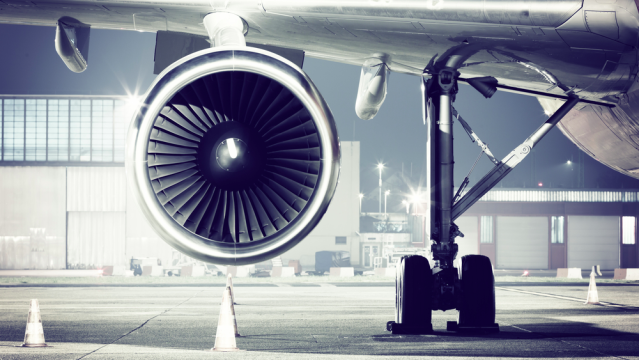I used to work at Boeing and repaired the computerised part of the machines which put together 747’s. People not familiar with aeroplanes are scared because they are forced to be quiet and go along with acting normal while stuck in a tube hurtling through the air at 965km/h, and 30,000 feet above the earth. What could go wrong?
Surprisingly, not much. These things are engineered and tested over and over to make sure they are safe. The number of deaths now — even from planes that crashed — is incredibly low. Most people now walk away from aircraft disasters unless the plane was blown up on purpose. That is hard to do now also. So let me show you a picture I’ve seen that many people never see. It is wings being bent in testing at a level they never would be in real life. They have to withstand every possible stress.

Image Credit: Boeing
Let’s get back to the noises and a checklist so you can know what is happening.
They have an APU at the back of the plane which is the auxiliary power unit. That baby hums along while you are boarding the plane to keep every thing up and running while the main engines are off. In addition, most airports hook the plane up to the ground units to pump air and electricity into the plane to save gas and money. When they close the door, you will hear a change and both the air and lights will flicker as they switch from the airport system to the aircraft system.
Then they will start each engine and you will hear the whine of the spin-up and then the ignition as it fires up, the roar. They usually have a tug (vehicle) push back the plane from the terminal though some planes actually can make the exhaust go in reverse to back the plane up.
The engines get louder to do this, then quiet down. Now it starts to taxi on the apron of the airport as the tower tells them where to get in line to use the assigned runway.
In mostly Airbus planes, they have a fuel saving device called the power transfer unit, or PTU. It is making sure the hydraulic pressure is balanced when they only use one engine during push-back and taxiing. Everyone wants to save fuel so this is their option. It’s noisy and a bit unnerving as it cycles on and off, on and off, on and off due to pressure fluctuations. It sounds like a dog in the hold with a high pitched bark to some — wooof-wooof-wooof wooof…
Airbus has another, higher pitched servo noise as prolonged whine which happens by the gate prior to departure and then after landing. It’s from an electric hydraulic pump used to open and close the cargo doors.
While they are taxiing, the wheels make a bump noise at each tar strip because there isn’t much of a shock absorber on aeroplanes. As they taxi, the pilot and copilot take the time to actually check all the systems on the plane making sure each one does what it is supposed to. There are lights which let them know every single function and if anything is even a little bit off.
It also might be interesting for you to know there are 4 separate systems built in every airliner so if one goes bad, there are three others to back it up. So you will hear the little servo electrical motors that move the control surfaces of the plane reassuring the pilots everything is working correctly.
It also might be reassuring for you to know, each of the pilots has an exact model of the aeroplane they are flying as a simulator they have to train on. While in that, the trainers turn off motors suddenly, have electrical systems fail, rudders not work — everything imaginable go wrong and the pilots have to land it safely or they fail. Your guys passed flight safety.
So back to the taxi. Now you are in line and next to go. The pilot moves out to the end of the runway where if you look out you can see a bunch of wide white stripes painted on the runway with a lot of black skid marks. That’s when they come in for a landing, the white tells the pilot where the end is. Your pilot wants the plane to get in the air easily so he flips a switch to make the wings almost twice as wide as they normally are. Those are flaps which make a whirring sound as the servos push them open. You can see them drop down if you’re sitting in back of the wing.
So now you hear the engines rev up and feel the push into your seat from moving forward. You’ll be able to tell if a wheel is a little out of round because the bump of the tar strips mingle with the speed of the spinning wheels as they speed up and go blump, blump, blump.
It always is a game I play to see how fast the aircraft needs to go before it can “plane” into the air. When it goes fast, the air gets thick and acts like water. Like sticking your hand out of the car window at 60 MPH. The aeroplane has to go at least a hundred miles an hour before it can bite into the air.
The pilot is watching a gauge which tells him exactly what it is. When it is just the right moment, he pulls back the control yoke and the nose wheel will spin like crazy. Then he pulls a little farther and you will hear both wing wheels come off the runway and spin like mad, but you won’t hear that slap any more.
Now you will hear some of those small electric motors as the wheels are pulled up into the plane and the snap of the doors closing, first one then the other. It will get noticeably quieter immediately. Now another whine as the pilot doesn’t need the big wing for takeoff any more, he will bring the flaps back into their normal place. All that is called cleaning up the plane so it is smooth and streamlined.
Now the engines are quieted down as they settle into gaining altitude while ground control tells them what direction to fly, making sure no one else is around your aeroplane. Next, the stewards get busy to make your flight pleasant as they can by serving you. Settle back and sleep or enjoy a view relatively few in the world ever get to experience.
When you land, you notice some of those noises again. First the engines will change tone and you feel a slight change as the plane slows down and starts to lower the nose. After a while, that may get even a little steeper while they are instructed where to get in line up in the air. Now the plane is going too fast so they slow it down by having some parts on top of the wing lift up a little which make a bunch of windy noise; you might hear some of those small electrical motors again. The pilots align the plane with the runway and start flying towards the end of the runway.
As they get close, they want that big wing again so they make those flaps come out from the back of the wing and sometimes they even make a little one open on the front of the wing to make it even larger. You can hear the wind like mad now and if you are by a window, sometimes see the air is being squished so much, it leaves little vapour trails which follow the airstream over the wing. There is a big noise as a bang and that is the landing gear doors being opened again, then bigger machine noises while the wheels are lowered into place until they lock with a click. Wind is really roaring.
The pilot has to see three green lights on his panel to know all the wheels are where they belong and it is safe. Next, he gets the plane at just the right speed over the end of the runway and slows the engines enough to let it touch the wheels. They bark like dogs as the tires go from a complete stop to spinning over a hundred miles an hour.
Then the pilots have to make sure the plane stays on the ground and stops so they flip a switch and a bunch of panels come out of the wings to force the plane to stay down and they have special shields on the engines which allow them to push air frontwards slowing the plane even more. They are loud roars.
You’ll notice a almost grinding noise as he steps on the brakes just like your car. He pushes down hard to slow the plane making that squally-grindy sound and you can feel the pressure of stopping. It usually pulses a little as he presses then lightens, then presses again. When it is slow enough, he pulls in all those parts of the wings needed to land safely with the whirring servo’s and then ground control tells him what taxiway he is to use to approach the terminal. He’s also told which gate he is assigned.
You will hear the dog in the hold on the airbus planes as the PTU balances out again. Once the pilot pulls up to a stop, he will shut off the engines and it will switch to the APU and then you’ll notice the flicker when the ground crew hooks up the service equipment to the plane. The bell boings and you get your luggage down. Breathe.
Now the only problem is dodging overhead luggage from people bringing everything they own to avoid baggage fees.
About the author: Mike Leary, Psychotherapist in private practice
This answer originally appeared on Quora.
